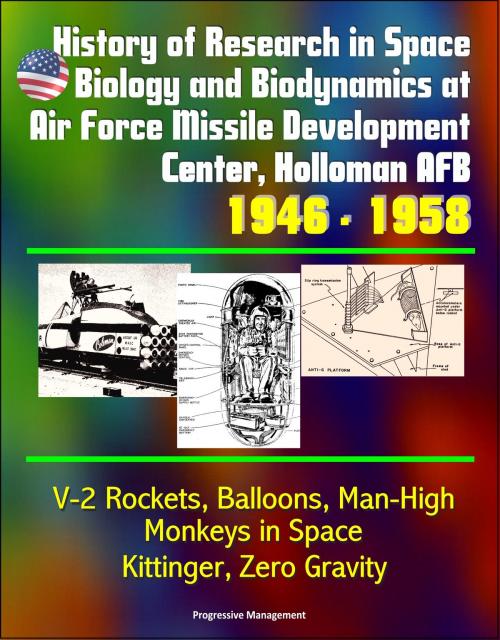History of Research in Space Biology and Biodynamics at Air Force Missile Development Center, Holloman AFB, 1946: 1958 - V-2 Rockets, Balloons, Man-High, Monkeys in Space, Kittinger, Zero Gravity
Nonfiction, Science & Nature, Technology, Aeronautics & Astronautics, History, Military, Aviation| Author: | Progressive Management | ISBN: | 9781310901362 |
| Publisher: | Progressive Management | Publication: | September 27, 2014 |
| Imprint: | Smashwords Edition | Language: | English |
| Author: | Progressive Management |
| ISBN: | 9781310901362 |
| Publisher: | Progressive Management |
| Publication: | September 27, 2014 |
| Imprint: | Smashwords Edition |
| Language: | English |
Here is the fascinating story of the early years of research into the effects of space on biology and the human body, focusing on the famous work at the Holloman Air Force Base Missile Development Center in New Mexico. Topics and subjects covered include: Project Man-High, the V-2 rocket, animal research, aerobee, monkeys in space, Winzen Research, General Mills, Balloons, Joseph W. Kittinger, Sky Car, Major David G. Simons, Operation Stratomouse, Lt. Colonel John P. Stapp, Rocket Sled experiments, Captain John D. Mosely, Threshold of Space, Project High-Dive, High-Chair, Cherokee Missile, Project Whoosh, Ejection Seat Testing, Daisy Truck, Automobile crash tests, Strato-lab.
CHAPTER I - THE BEGINNINGS OF RESEARCH IN SPACE BIOLOGY AT THE AIR FORCE MISSILE DEVELOPMENT CENTER, 1946-1952 (issued January 1958) * CHAPTER II - MAJOR ACHIEVEMENTS IN SPACE BIOLOGY AT THE AIR FORCE MISSILE DEVELOPMENT CENTER, 1953-1957 (issued March 1958) * 1. Important Technological Developments * 2. Achievements in Cosmic Radiation Studies * 3. Project Man-High Notes * CHAPTER III - HISTORY OF RESEARCH IN SUBGRAVITY AND ZERO-G AT THE AIR FORCE MISSILE DEVELOPMENT CENTER, 1948- 1958 (issued May 1958) . * Later Subgravity Studies at Holloman, 1954-1958 * The Present Outlook for Experimentation in Subgravity Conditions * CHAPTER IV - MAJOR ACHIEVEMENTS IN BIODYNAMICS: ESCAPE PHYSIOLOGY AT THE AIR FORCE MISSILE DEVELOPMENT CENTER, 1953-1958 (issued June 1958) * Deceleration and Windblast Experiments on the Holloman Track * Specialized Windblast Studies, 1955-1958 * Other Work on the Escape Problem * Seats and Capsules: Conflicting Views of Escape * CHAPTER V - RESEARCH ACCOMPLISHMENTS IN BIODYNAMICS: DECELERATION AND IMPACT AT THE AIR FORCE MISSILE DEVELOPMENT CENTER, 1955-1958 (issued October 1958) * Aircraft Crash Forces * Later Deceleration Studies on the High-Speed Track * Other Research Related to G-Forces Anticipated in Space Flight * Tolerance to Impact Forces (Task 78503); Research on the Daisy Track and Related Test Facilities * Tolerance to Total Pressure Change: Task 78504 * Automotive Crash Forces * CHAPTER VI - ADMINISTRATIVE HISTORY OF THE AEROMEDICAL FIELD LABORATORY AT THE AIR FORCE MISSILE DEVELOPMENT CENTER, 1951-1958 (issued July 1958) * The Laboratory Mission and the Project Workload, 1954-1958 * Administrative Organization and Resources * GLOSSARY
Since its inception a half-century ago, the United States Air Force has constantly operated higher and higher, faster and faster, until it has all but shattered the barriers of physical forces and alien physical environments which throughout all history have confined the activities of man to the immediate vicinity of the earth. With every advance in velocity and altitude resulting from new types of high-performance aircraft, rockets or satellites, the potential operational environment of the Air Force has expanded until today the actual area of operations extends to the very borders of interplanetary space and the immediate potential includes the vast central portion of the solar system. And with every advance of the environmental parameters, man encounters physical and biological hazards unique in his experience. For many years, scientists of the Biodynamics and Space Biology Branches and more recently organized units of the Air Force Missile Development Center's Aeromedical Field Laboratory have sought to identify and understand the nature of these hazards, and to perfect protective devices and techniques for the benefit of man operating at high altitudes within the atmosphere and in the limitless space beyond. Because of the nature of its projects, the Laboratory occupies a unique position among the many other major units of the Center. It is one of the units working most directly toward man's ultimate conquest of space and was actively working toward this objective even during the years that "space work" was in official Air Force and Congressional disfavor as "impractical."
Here is the fascinating story of the early years of research into the effects of space on biology and the human body, focusing on the famous work at the Holloman Air Force Base Missile Development Center in New Mexico. Topics and subjects covered include: Project Man-High, the V-2 rocket, animal research, aerobee, monkeys in space, Winzen Research, General Mills, Balloons, Joseph W. Kittinger, Sky Car, Major David G. Simons, Operation Stratomouse, Lt. Colonel John P. Stapp, Rocket Sled experiments, Captain John D. Mosely, Threshold of Space, Project High-Dive, High-Chair, Cherokee Missile, Project Whoosh, Ejection Seat Testing, Daisy Truck, Automobile crash tests, Strato-lab.
CHAPTER I - THE BEGINNINGS OF RESEARCH IN SPACE BIOLOGY AT THE AIR FORCE MISSILE DEVELOPMENT CENTER, 1946-1952 (issued January 1958) * CHAPTER II - MAJOR ACHIEVEMENTS IN SPACE BIOLOGY AT THE AIR FORCE MISSILE DEVELOPMENT CENTER, 1953-1957 (issued March 1958) * 1. Important Technological Developments * 2. Achievements in Cosmic Radiation Studies * 3. Project Man-High Notes * CHAPTER III - HISTORY OF RESEARCH IN SUBGRAVITY AND ZERO-G AT THE AIR FORCE MISSILE DEVELOPMENT CENTER, 1948- 1958 (issued May 1958) . * Later Subgravity Studies at Holloman, 1954-1958 * The Present Outlook for Experimentation in Subgravity Conditions * CHAPTER IV - MAJOR ACHIEVEMENTS IN BIODYNAMICS: ESCAPE PHYSIOLOGY AT THE AIR FORCE MISSILE DEVELOPMENT CENTER, 1953-1958 (issued June 1958) * Deceleration and Windblast Experiments on the Holloman Track * Specialized Windblast Studies, 1955-1958 * Other Work on the Escape Problem * Seats and Capsules: Conflicting Views of Escape * CHAPTER V - RESEARCH ACCOMPLISHMENTS IN BIODYNAMICS: DECELERATION AND IMPACT AT THE AIR FORCE MISSILE DEVELOPMENT CENTER, 1955-1958 (issued October 1958) * Aircraft Crash Forces * Later Deceleration Studies on the High-Speed Track * Other Research Related to G-Forces Anticipated in Space Flight * Tolerance to Impact Forces (Task 78503); Research on the Daisy Track and Related Test Facilities * Tolerance to Total Pressure Change: Task 78504 * Automotive Crash Forces * CHAPTER VI - ADMINISTRATIVE HISTORY OF THE AEROMEDICAL FIELD LABORATORY AT THE AIR FORCE MISSILE DEVELOPMENT CENTER, 1951-1958 (issued July 1958) * The Laboratory Mission and the Project Workload, 1954-1958 * Administrative Organization and Resources * GLOSSARY
Since its inception a half-century ago, the United States Air Force has constantly operated higher and higher, faster and faster, until it has all but shattered the barriers of physical forces and alien physical environments which throughout all history have confined the activities of man to the immediate vicinity of the earth. With every advance in velocity and altitude resulting from new types of high-performance aircraft, rockets or satellites, the potential operational environment of the Air Force has expanded until today the actual area of operations extends to the very borders of interplanetary space and the immediate potential includes the vast central portion of the solar system. And with every advance of the environmental parameters, man encounters physical and biological hazards unique in his experience. For many years, scientists of the Biodynamics and Space Biology Branches and more recently organized units of the Air Force Missile Development Center's Aeromedical Field Laboratory have sought to identify and understand the nature of these hazards, and to perfect protective devices and techniques for the benefit of man operating at high altitudes within the atmosphere and in the limitless space beyond. Because of the nature of its projects, the Laboratory occupies a unique position among the many other major units of the Center. It is one of the units working most directly toward man's ultimate conquest of space and was actively working toward this objective even during the years that "space work" was in official Air Force and Congressional disfavor as "impractical."















